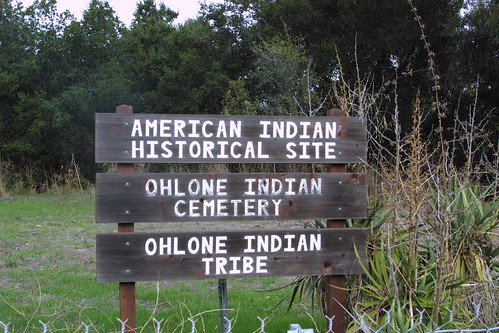I’ve already told you that I participated in Day One of the Shellmound Peace Walk on November 17, 2010, and pointed you to the article I wrote for Milpitas Patch. Here’s why I walked.
The Ohlone Indians lived around the Bay for thousands of years before Europeans arrived. The Spanish missionaries arrived in the 17th century and once they baptized Indians, the missionaries treated them as property of Spain. They were confined to the mission compounds and forcibly brought back if they tried to escape. Revolts were answered by lethal retaliation. Physically they were worn down by imposed labor and sickened and killed by unfamiliar diseases. The old and the very young were particularly susceptible. There are reports of abuse of every nature. Their culture was erased.
When the mission era ended and California became an American state, the Indians were set free but their homes and way of life were gone. They suffered horrible persecution at the hands of Americans, from denial of civil rights to murder. Some went underground, pretending to be Mexican just to get by.
The Native Americans did what mankind does. They adapted and they survived. They kept their spiritual roots intact, never forgetting their languages, their songs, their medicines, and their values. In the 1960s and ’70s they reclaimed their identity, shouldered their history, and politically activated. They’re making tremendous strides but many still carry the social scars from the trauma they suffered starting with Spanish contact.
Meanwhile after reaping the benefits of the Gold Rush, agriculture, and the Industrial Revolution, Americans in California started to rediscover the state’s Spanish past. In 1884 Helen Hunt Jackson published her novel Ramona which romanticized the mission era and sparked a new expression of California identity: a western paradise on the Pacific coast infused with Mexican charm. The crumbling missions were literally revived and rebuilt and became cornerstones of communities and tourist draws. El Camino Real was reinvented as a continuous highway from San Diego to San Francisco. Most recently I caught the bug and climbed on board the nostalgia train. I celebrate El Camino, what it is today and what I think it will be. But I have to face its past, and that includes the pain of the Ohlone.
That’s why I went on the Shellmound Peace Walk, to experience the history firsthand. “El Camino” means “the road,” and a road is one of the fundamental ways a people leave their mark on the Earth. Walking a road means following the footsteps of those who went before. Where a bit of nature remainedthe Alviso slough, Coyote Creek, the Diablo Mountain RangeI could see what earlier people saw and immerse myself in the immutable sense of place. The physical exertion of walking reminded me of my universal humanity, and sharpened my motivations as I reflected on the multitude of emotions that preceded me there: hope, fear, elation, sorrow. Walking with Indians, some of them descendants of Ohlones, was a gift. Talking with them connected me directly to the people of this land not just through earth, but through flesh, blood, and spirit. Walking with non-Indians bolstered my faith in friendship and fraternity. Injustice shared is peace conceived.
I will continue to celebrate El Camino Real. It has a story to tell and I will continue to listen and share what I hear. El Camino remembers the Ohlone. So do we all.
